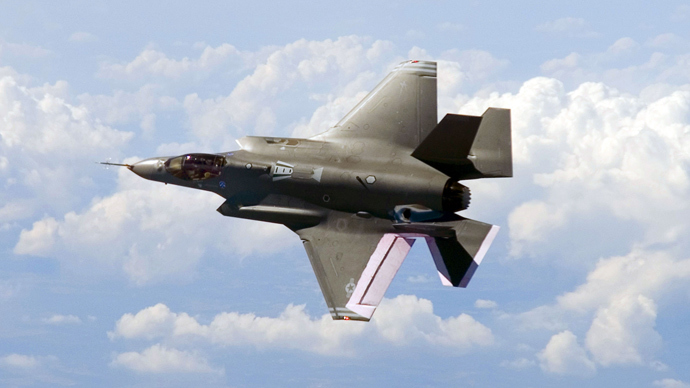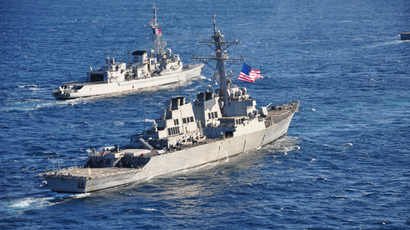Bombs away: Pentagon’s F-35 Joint Strike Fighter can’t escape software problems

The US Defense Department has warned of reoccurring technical problems with Lockheed Martin’s F-35 stealth fighter, the Pentagon’s costliest weapons program that has already come under heavy criticism.
The Pentagon's chief weapons tester, Michael Gilmore, provided an
in-depth look at the F-35's technical features, emphasizing what
he calls the "unacceptable" characteristics of the aircraft's
software, according to a draft obtained by Reuters.
The 25-page report, scheduled to be delivered to Congress this
week, provided a disturbing glimpse of the aircraft’s Block 2B
software, which is currently not performing at the level of
earlier expectations and could significantly delay deployment of
the plane.
"Initial results with the new increment of Block 2B software
indicate deficiencies still exist in fusion, radar, electronic
warfare, navigation, electro-optical target system, distributed
aperture system, helmet-mounted display system, and
datalink," the report said.
The software issued too many “nuisance warnings” that
resulted in “poor sensor performance,” the report said,
adding that Lockheed Martin had delivered F-35 jets with 50
percent or less of the software capabilities as stipulated by its
contract with the Pentagon.
Due to the high number of technical problems, the 2B software
overhaul would not be finished until November 2015 - 13 months
later than originally planned, the report forecast. This would
delay release to the F-35 fleet until July 2016, a year after the
Marine Corps anticipated using the aircraft.
The F-35, which is designed to be able to hover like a
helicopter, is expected over the next decade to provide firepower
to the US Air Force, Marine Corps and Navy. Several members of
NATO, the 28-member Western military bloc, have expressed
interest in the fighter jet, including Australia, Britain and
Canada.
Gilmore, who has been an outspoken critic of the F-35 Joint
Strike Fighter, the Pentagon's costliest weapons program with a
price tag of $392 billion for 2,443 aircraft, said engineers were
still grappling with the problem of integrating the jet's
"mission systems," or avionics and weapons required for
engaging the enemy.
The onboard logistics system known as ALIS – which is defined as
the “information infrastructure for the F-35” on
Lockheed’s website - was said to contain "serious
deficiencies" and “failed to meet even basic
requirements.” At the same time, the report said the
aircraft’s heavy reliance on a vast web of electronics made it a
target for not only enemy fire, but lightning as well.
Lockheed describes ALIS on its website as “the information
infrastructure for the F-35, transmitting aircraft health and
maintenance action information to the appropriate users on a
globally-distributed network to technicians worldwide.”
Not everybody inside of the Defense Department, however, is so
downbeat on the technical aspects and future prospects of the
F-35 stealth fighter.
Air Force Lieutenant General Chris Bogdan, the Pentagon's F-35
program chief, stood by the state-of the-art machine.
"The basic design of the F-35 is sound, and test results
underscore our confidence in the ultimate performance that the
United States and its international partners and allies value so
highly," Bogdan told Reuters in a statement. "Of course,
we recognize risks still exist in the program, but they are
understood and manageable."
Bogdan, who believes the aircraft could enter service for the
Marines next year as planned, pointed to a number of successful
weapons tests late last year. According to the aircraft’s program
chief, the F-35 conducted 1,153 flights and carried out more than
9,000 tests in 2013.
However, it is not just technical issues that have critics of the
aircraft in an uproar.
The F-35 Joint Strike Fighter program, which started in 2001, is
70 percent over initial cost estimates, and years behind
schedule. And despite its fantastic price tag, the F-35 has even
failed to generate the number of jobs its proponents had
originally promised to Congress.
Earlier this week, the Center for International Policy said
Lockheed had “greatly exaggerated” its claim that the F-35
program will sustain 125,000 American jobs in 46 US states in an
effort to win support for the program.
In the latest bit of bad news for the US government’s largest
contractor, shares in Lockheed Martin tumbled after its
fourth-quarter profit plunged 14 percent amid US budget cuts.
Lockheed declined 3.9 percent on Thursday to close at $150.49. It
was the biggest drop since August 10, 2011.














